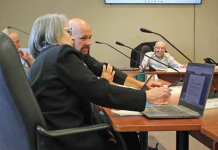Dysart council has turned down an application from Rogers to install a new 90-metre cell tower on Minnicock Lake Road, though the project may not be completely dead.
Following a debate July 26 over the proposed location of the tower, councillors split a 3-3 vote in a move that saw the project – the first to come to the municipality through the Eastern Ontario Regional Network’s (EORN) cell gap initiative – defeated. Deputy mayor Pat Kennedy was absent from Tuesday’s meeting. Tie votes result in defeated motions.
Mayor Andrea Roberts labelled council’s decision an embarrassment.
“I’m not sure what the next steps are. I’m very disheartened,” Roberts said. “We will be left behind in the dust. If this is the legacy this council wants to leave, that’s what it is.”
Roberts and councillors Walt McKechnie and Nancy Wood-Roberts voted in favour of the proposal, while Tammy Donaldson, Larry Clarke and John Smith shot it down.
Clarke said he was concerned the project appeared to fly in the face of Dysart’s policy 38 – legislation introduced in 2014 regulating the use and installation of cell towers. That policy stipulates any proposed towers should be located a minimum of one-kilometre from the nearest residence; be camouflaged or designed to blend with the surroundings, with the natural-looking Mono-pine structures preferred; be set back a minimum of 60 metres from the nearest road, and feature the minimum required lighting to meet Transport Canada safety standards.
Earlier that day, council heard from Michael Butz, who lives in one of 40 residences within a one-kilometre radius of the proposed site. He called on council to uphold the requirements outlined in policy 38. He noted a petition organized by his neighbours, opposing the project, had garnered over 100 signatures.
He identified a potential site 4.5 kilometres south of the Minnicock Lake Road location, which he said would be a “perfect fit” for a tower, with the nearest residence over a kilometre away.
Rogers spokesperson Eric Belchamber told council that location wouldn’t be viable.
“Having a tower one kilometre away from where people live isn’t practical… It wouldn’t have a meaningful impact on improving service and achieving the EORN goals,” he said. “Policy 38 is one of the most onerous policies I’ve come across. It was written with what seems to be a sentiment of not wanting cell towers [in Dysart].”
Smith said if Rogers had issues with the policy, they should have been raised when the process began 18 months ago.
Donaldson said her belief is that 5G technology is unsafe for human health.
“There is no health risk whatsoever to humans through this technology,” Belchamber said.
Christian Lee, a site acquisition specialist with Rogers, expressed confusion over Donaldson’s comments given that Innovation, Science and Economic Development Canada (ISED) outlined in its information for municipal councils that these type of concerns were unfounded and unwarranted and should not be part of the decision-making process.
Belchamber noted this was only the second out of around 85 EORN projects he’s worked on in the past year to have been rejected. He mentioned Rogers was working on five other cell tower location sites in Dysart.
Roberts asked Clarke, Smith and Donaldson what would have to happen to change their minds. Clarke said he would be willing to revisit the issue should council revise policy 38. CAO Tamara Wilbee said it would be brought forward at next month’s committee of the whole meeting.
“We have policies in place for a reason. Our residents are looking at us to uphold policy 38… and I think we have to do that in this case,” Clarke said. “If it can be revised and the site can still work within the policy, then I’ll support it.”





